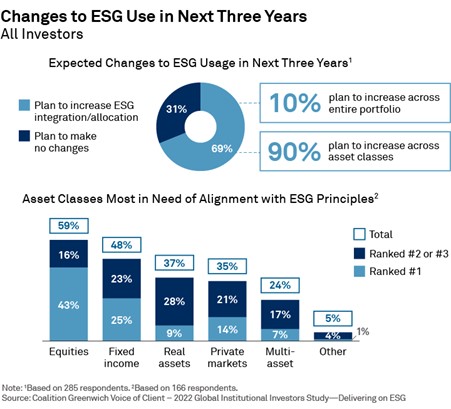Greater understanding and evidence of ESG performance needed from investment managers - report

North American institutional investors, particularly US investors, lag behind Europe and Asia when it comes to environmental, social, and governance (ESG) investment strategies, says the ‘Coalition Greenwich Voice of Client – 2022 Global Institutional Investors Study – Delivering on ESG.’
Globally, 75% of investors incorporate ESG strategies, with Europe leading at 92%, followed by Asia at 76%. However, North America trails at 53%, driven mainly by Canadian investors.
ESG considerations vary across regions
Making a positive impact on society, particularly the environment, has become a top objective for using ESG strategies for many investors. However, investors’ ESG considerations differ across regions, with Europeans focusing on climate change and carbon emissions, while North Americans emphasize diversity and inclusion, and Asians prioritize business ethics.
In addition, net-zero targets have gained traction, with 15% of institutional investors globally setting such targets, and around a quarter of European investors adopting them. In contrast, only 5% of North American investors have implemented net-zero targets.
The leading factor on why Europe and Asia are leading North America in ESG investing is the length of time these markets have had exposure to ESG investing, says Sophie Emler, senior relationship manager, Coalition Greenwich and author of the study.
Disparity between the US and Canada
She notes that there is significant disparity between the US and Canada as well. “In our study, Canada makes up the majority of ESG users for North America and is much further ahead than the US. Canada is probably more on par with Asia and the US much further behind.
One of the reasons North American investors are wary of ESG investment factors is their focus that fiduciary duty should come above all else. “There’s still fiduciary duty in Europe,” says Emler. “But the understanding of fiduciary duty is different. There's an understanding in Europe that making investment choices that align with ESG don't necessarily come at the expense of returns.
“In fact, ESG investing is about de-risking portfolios for the future, and by de-risking along those lines you're in fact protecting your risk return profile for the longer-term future and, therefore, it is entirely in alignment with fiduciary duty.”
Emler says likely the US takes a more short-term view. “Across all of the markets we looked at, investors had a slightly more neutral view on the impact of ESG on risk return profiles in the short term. Over the long term, they do believe there is a significant positive impact on risk return profiles.”
Regulatory-driven regions
Another driver as to why Europe and Asia have a greater uptake is that these regions are regulatory driven. “Sustainable Finance Disclosures Regulations (SFDRs) in Europe are essentially forcing managers to make disclosures around things like environmental risks to portfolios.
“So, when they look at risk return, it’s not just traditional finance risk they're looking at. They have to look at things like environmental risk and climate risk and the potential long-term headwinds those will cause to portfolios.
“Similarly, there are regulations in Singapore and Hong Kong, so managers have to make disclosures around environmental risks to portfolios.
“I don't believe those regulations exist in North America, particularly not in the US and, therefore, there is not the same drive or a regulatory push from financial regulatory bodies for managers to look at ESG in the same way.”
Emler believes if there is a set of regulations at the country level for institutional investment, it would go a long way towards driving ESG use.
Understand the balance of risk and return
She adds that investors will need to understand the balance of risk and return and that longer-term risks to portfolios should evolve from how they have been traditionally modelled. “They should include things such as environmental, social, and governance factors because they do present potential headwinds to returns in the long term.
“There should be an integrated approach towards investment philosophy and process. It should not consist of separate thoughts or include afterthoughts, but comprise an holistic approach to the design and modelling of the portfolio.”

ESG integration outlook
Looking ahead, the study shows approximately 70% of large institutional investors plan to increase ESG integration in their allocations, especially in equities and fixed income.
The study says ESG-based investment strategies are gaining prominence globally, driven by the desire to make a positive societal impact. Net-zero targets are becoming more prevalent, but greater understanding and evidence of ESG performance are needed from investment managers.



